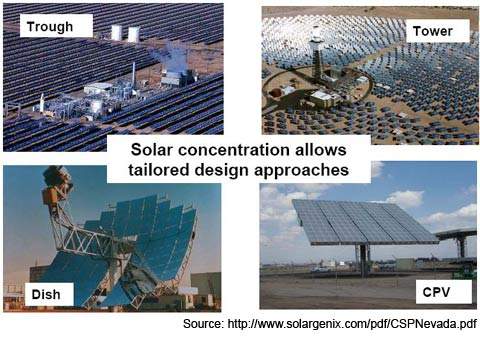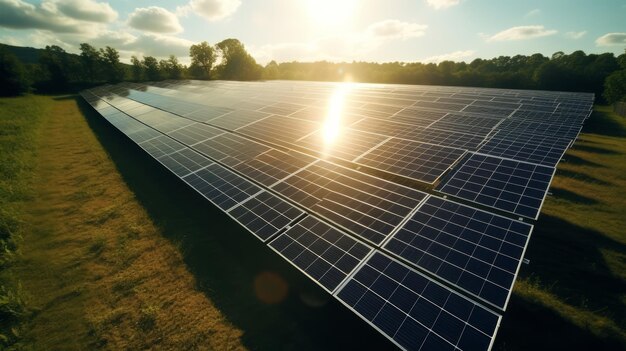
Concentrated Solar Power (CSP) Technology Explained: Harnessing the Sun’s Heat for 24/7 Energy
The sun, our ultimate energy source, bathes the Earth in an incredible amount of power every single day. While we’re all familiar with rooftop solar panels that convert sunlight directly into electricity (Photovoltaic or PV solar), there’s another fascinating and powerful way to harness the sun’s energy: Concentrated Solar Power (CSP).
Often overshadowed by its PV cousin, CSP technology is a true marvel of engineering, capable of providing reliable, dispatchable electricity even after the sun goes down. Imagine a giant magnifying glass focusing the sun’s rays to generate immense heat – that’s the core principle behind CSP.
In this comprehensive guide, we’ll dive deep into the world of Concentrated Solar Power, explaining how it works, its various forms, the magic of its unique storage capabilities, and why it’s a critical player in our global shift towards a sustainable energy future.
What is Concentrated Solar Power (CSP)?
At its heart, Concentrated Solar Power (CSP) is a renewable energy technology that uses mirrors to focus a large area of sunlight onto a small area. This concentrated sunlight generates high temperatures, which are then used to produce steam, drive a turbine, and ultimately generate electricity.
Think of it like this:
- PV Solar Panels: Directly convert sunlight into electricity using semiconductors. They’re great for smaller scales and direct power use.
- CSP: Converts sunlight into heat, and then uses that heat to generate electricity. This heat can also be stored, making CSP a unique and powerful option for large-scale power generation.
The key differentiator for CSP is its ability to store thermal energy, allowing it to generate electricity even when the sun isn’t shining – a crucial advantage over many other renewable sources.
How Does CSP Work? The Basic Principles
While there are different types of CSP systems, they all follow a similar fundamental process:
- Collection: Large arrays of mirrors (often called "heliostats" or "collectors") are designed to precisely track the sun’s movement throughout the day.
- Concentration: These mirrors reflect and focus the sunlight onto a central receiver or a series of tubes.
- Heat Transfer: Inside the receiver or tubes, a heat transfer fluid (HTF) – often synthetic oil, molten salt, or even water – absorbs the concentrated solar energy, heating up to extremely high temperatures (sometimes over 550°C or 1000°F!).
- Power Generation: The superheated HTF then generates steam, much like a conventional power plant. This high-pressure steam drives a turbine, which in turn spins a generator to produce electricity.
- Thermal Energy Storage (Optional, but Key): This is where CSP truly shines! Instead of directly converting all the heat to electricity, a portion can be diverted to a storage system, typically using molten salt. This stored heat can then be used to generate electricity later, during cloudy periods or after sunset.
Let’s break down the different ways these principles are applied in various CSP technologies.
Types of CSP Technologies: Different Ways to Catch the Sun
The world of CSP isn’t a one-size-fits-all solution. Different mirror configurations lead to distinct technologies, each with its own advantages and applications.
1. Parabolic Trough Systems
- How it Works: This is the most commercially mature and widely deployed CSP technology. It uses large, curved, trough-shaped mirrors (like a giant U-shape) that are parabolic in cross-section. These troughs focus sunlight onto a receiver tube running along the focal line of the trough. A heat transfer fluid (HTF), typically synthetic oil, flows through this tube and absorbs the heat.
- Process: The heated HTF is then pumped through a series of heat exchangers to boil water, producing steam. This steam drives a conventional turbine to generate electricity.
- Key Features:
- Mature Technology: Proven track record in large-scale power plants.
- Modular Design: Can be built in sections, allowing for scalability.
- Integrated Storage: Often combined with molten salt storage systems to provide dispatchable power.
- Analogy: Imagine many long, shiny, U-shaped gutters all lined up, focusing the sun’s rays onto a pipe running along their center.
2. Solar Power Tower (Central Receiver Systems)
- How it Works: This impressive technology uses a field of thousands of large, flat, sun-tracking mirrors called "heliostats." Each heliostat individually tracks the sun and reflects its rays onto a central receiver located atop a tall tower.
- Process: The concentrated sunlight heats a fluid (most commonly molten salt, but sometimes water/steam or air) inside the receiver to extremely high temperatures (up to 600°C or even higher). This superheated fluid is then used to generate steam, which drives a turbine.
- Key Features:
- High Temperatures: Achieves the highest temperatures among CSP technologies, leading to potentially higher efficiency.
- Excellent for Storage: Molten salt, used as the HTF, also doubles as an ideal thermal energy storage medium. The hot salt can be stored for hours, providing power long after sunset.
- Large Scale: Often used for very large power plants.
- Analogy: Picture a vast, flat desert landscape dotted with thousands of shimmering mirrors all pointing towards a single, tall skyscraper in the distance. The top of that skyscraper is glowing intensely from the focused sunlight.
3. Dish-Engine Systems
- How it Works: This technology uses a large, parabolic dish-shaped mirror (similar to a satellite dish) to focus sunlight onto a receiver located at its focal point. Attached to the receiver is a Stirling engine or another type of heat engine.
- Process: The concentrated sunlight heats the working fluid inside the Stirling engine, causing it to expand and contract, driving pistons that turn a generator directly.
- Key Features:
- High Efficiency: Can achieve very high solar-to-electric conversion efficiencies on a smaller scale.
- Modular and Distributed: Each dish-engine unit is a self-contained power plant, suitable for smaller, decentralized applications.
- No Water Needed (for cooling engine): Stirling engines are often air-cooled.
- Analogy: Think of a giant, shiny satellite dish, but instead of receiving TV signals, it’s focusing sunlight onto a small engine right in front of it.
4. Linear Fresnel Reflector Systems
- How it Works: This system uses long, parallel rows of flat or slightly curved mirrors (Fresnel reflectors) that focus sunlight onto a receiver tube mounted above them. Unlike parabolic troughs, the mirrors are simpler and cheaper to manufacture.
- Process: Similar to parabolic troughs, a heat transfer fluid flows through the receiver tube, gets heated, and then generates steam to drive a turbine.
- Key Features:
- Simpler Mirrors: Flat or slightly curved mirrors are less complex and potentially cheaper to produce than parabolic troughs.
- Less Land Area (Potentially): Mirrors can be placed closer together.
- Good for Process Heat: Can also be used to provide industrial process heat directly.
- Analogy: Imagine many long, flat strips of mirror laid out side-by-side, each slightly angled to reflect sunlight up to a single pipe running above them.
The Magic of Thermal Energy Storage (TES)
This is perhaps the most exciting and crucial aspect that sets CSP apart from most other renewable energy sources, especially traditional PV solar panels.
What is TES?
Thermal Energy Storage (TES) allows CSP plants to store the heat generated during sunny hours and use it to produce electricity later, even when the sun isn’t shining. This means CSP can provide dispatchable power – electricity that can be delivered on demand, just like a conventional fossil fuel power plant.
How does it work, typically with Molten Salt?
The most common and effective medium for TES in CSP plants is molten salt.
- During the day, when the sun is abundant, excess heat from the solar field is used to heat a mixture of salts (typically sodium nitrate and potassium nitrate) to very high temperatures (e.g., 550°C).
- This hot molten salt is stored in large, insulated tanks.
- When the sun sets, or during cloudy periods, the hot molten salt is pumped from its "hot" tank to a "cold" tank, passing through a heat exchanger along the way.
- In the heat exchanger, the hot salt transfers its energy to water, creating superheated steam.
- This steam then drives the turbine to generate electricity, just as it would during daylight hours.
Why is TES so important?
- 24/7 Power: Enables CSP plants to operate around the clock, providing baseload or peak load power whenever needed.
- Grid Stability: Helps stabilize the electrical grid by providing a reliable and predictable source of renewable energy, reducing reliance on fossil fuel "peaker" plants.
- Increased Value: Makes solar energy more valuable by extending its availability beyond daylight hours, effectively "firming" the renewable supply.
- Flexibility: Allows plant operators to produce electricity when demand (and prices) are highest, optimizing economic returns.
Why CSP Matters: Key Benefits
CSP offers a compelling set of advantages that make it a vital component of a sustainable energy future:
- Dispatchable, On-Demand Power: As discussed with TES, CSP’s ability to store energy means it can provide power reliably, even at night or during cloudy weather. This is a game-changer for grid integration of renewables.
- Renewable and Clean Energy: CSP uses an inexhaustible resource (the sun) and produces zero greenhouse gas emissions during operation. It’s a key tool in combating climate change.
- Large-Scale Power Generation: CSP plants are designed for utility-scale power generation, capable of producing hundreds of megawatts, comparable to traditional power plants.
- Energy Independence: Reduces reliance on imported fossil fuels, enhancing national energy security.
- Economic Development and Job Creation: Construction and operation of large CSP plants create numerous local jobs in manufacturing, construction, and plant maintenance.
- Potential for Industrial Process Heat: The high temperatures generated by CSP can also be used directly for industrial processes that require heat, reducing fossil fuel consumption in industries like manufacturing, food processing, and chemical production.
- Hybrid Solutions: CSP plants can be easily hybridized with other energy sources (e.g., natural gas for backup, or even biomass) to further enhance reliability and flexibility.
Challenges and the Future of CSP
While CSP offers immense potential, it also faces certain challenges that are being actively addressed by research and development:
- High Upfront Capital Costs: CSP plants, particularly solar towers with large heliostat fields, require significant initial investment compared to other forms of solar or even some fossil fuel plants. However, costs are declining as technology matures and economies of scale are achieved.
- Land Use: CSP plants require substantial land areas to accommodate the vast mirror fields. This needs careful planning and consideration of environmental impacts.
- Water Consumption: Many CSP plants use water for cooling towers (similar to conventional power plants) and for cleaning the mirrors. This can be a concern in arid regions where CSP plants are most efficient. However, innovations like dry cooling and robotic cleaning are reducing water requirements.
- Complexity: The systems are more complex than simple PV arrays, requiring specialized engineering and maintenance.
- Market Competition: CSP competes with increasingly cheaper PV solar and wind power, which don’t require the same level of thermal storage integration for basic generation.
The Future of CSP:
Despite these challenges, the outlook for CSP remains positive. Ongoing research is focused on:
- Cost Reduction: Developing cheaper, more efficient mirrors, receivers, and storage materials.
- Higher Temperatures: Exploring new fluids and materials to achieve even higher operating temperatures, leading to greater efficiency.
- Hybrid Systems: Integrating CSP with other renewables or even small amounts of fossil fuels to optimize performance and reduce costs.
- New Applications: Expanding CSP’s role in industrial process heat and desalination.
- Policy Support: Government policies and incentives are crucial for driving down costs and accelerating deployment.
As the world seeks more reliable and sustainable energy solutions, CSP’s unique ability to provide dispatchable, clean power positions it as a vital technology for the coming decades.
CSP vs. Photovoltaic (PV) Solar Panels: A Quick Comparison
It’s easy to confuse CSP with the more common PV solar panels, but they serve different primary roles in the energy landscape.
| Feature | Concentrated Solar Power (CSP) | Photovoltaic (PV) Solar Panels |
|---|---|---|
| Energy Conversion | Sunlight to Heat (thermal energy), then heat to electricity | Sunlight directly to Electricity (electrical energy) |
| Key Output | High-temperature heat (for steam) | Direct Current (DC) electricity |
| Storage | Excellent, inherent thermal energy storage (e.g., molten salt) | Requires separate battery storage (often expensive) |
| Dispatchability | Highly dispatchable (can provide power 24/7) | Intermittent (produces power only when sun is shining) |
| Scale | Typically utility-scale (large power plants) | Residential, commercial, and utility-scale |
| Efficiency | Good, especially with high temperatures and storage | Good, continually improving, but limited by semiconductor physics |
| Complexity | More complex (turbines, heat exchangers, fluid systems) | Simpler (solid-state electronics) |
| Water Use | Can be significant (for cooling/cleaning), but improving | Minimal (for cleaning, not operation) |
| Best Use Case | Large-scale, reliable, dispatchable power | Distributed generation, rooftop solar, grid integration |
Both CSP and PV are crucial for a renewable energy future. They are not competitors but rather complementary technologies, each playing to their strengths to build a robust and resilient clean energy grid.
Conclusion
Concentrated Solar Power (CSP) represents a powerful and sophisticated approach to harnessing the sun’s energy. By focusing sunlight to generate intense heat, and crucially, by storing that heat for later use, CSP plants offer a unique solution for providing reliable, dispatchable, and clean electricity around the clock.
As the world accelerates its transition away from fossil fuels, technologies like CSP will become increasingly vital. Its ability to provide continuous power, its large-scale potential, and its declining costs make it a cornerstone of a truly sustainable and secure energy future. While challenges remain, the innovation in this field is relentless, promising a bright and hot future for Concentrated Solar Power. The sun’s heat, once a simple warmth, is now a powerful, storable resource ready to fuel our world.



Post Comment